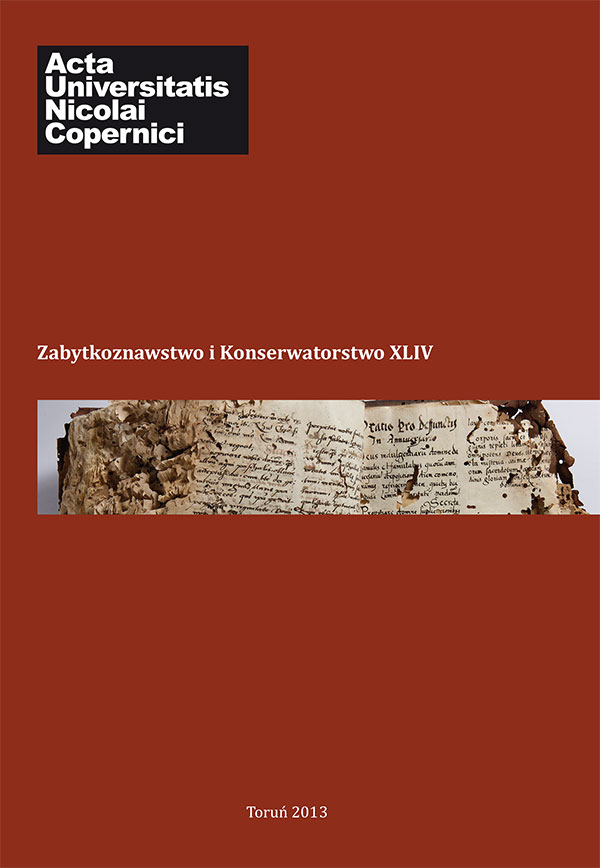Problematyka konserwatorska obrazów na filcu na przykładzie „Martwej natury” Antoniego Zydronia
DOI:
https://doi.org/10.12775/AUNC_ZiK.2013.017Abstrakt
This article refers to the issues of conservation and restoration of modern and contemporary art. It deals with the problem of paintings on felt support based on the example of “Still life group” by Antoni Zydroń. The artist used to create in his own technique, looking for new ways of expression, experimenting with media and materials. His still art is an oil painting with various additives like metallic filings, pastels, spray paints. Instead of linen canvas Zydroń used a blanket made of felted woolen textile as a support. Specific structure of the painting had an influence on its poor condition. The main conservation problem was flaking of paint layer. Felt is a very absorbent material w of its binders, causing the loss of its adhesion and cohesion. As a result of that, the colour and ground layers started detaching from the support. Moreover, the structure of the felt was weakened by common clothes moths. Damaged and thinned material could not no longer carry a weightiness of the paint layers. Conservation treatment was, in the first place, focused on inhibiting the deterioration of support and reinforcing flexibility and adhesion of painting layers. Due to the atypical technique examinations of methods and materials were carried out in order to determine optimal consolidant and lining textile.hich deprived the paint layer of its binders, causing the loss of its adhesion and cohesion. As a result of that, the colour and ground layers started detaching from the support. Moreover, the structure of the felt was weakened by common clothes moths. Damaged and thinned material could not no longer carry a weightiness of the paint layers. Conservation treatment was, in the first place, focused on inhibiting the deterioration of support and reinforcing flexibility and adhesion of painting layers. Due to the atypical technique examinations of methods and materials were carried out in order to determine optimal consolidant and lining textile.
Pobrania
Opublikowane
Jak cytować
Numer
Dział
Licencja
CC BY-ND 4.0. Posiadaczem prawa autorskiego (Licencjodawcą) jest Autor, który na mocy umowy licencyjnej udziela nieodpłatnie prawa do eksploatacji dzieła na polach wskazanych w umowie.
- Licencjodawca udziela Licencjobiorcy licencji niewyłącznej na korzystanie z Utworu/przedmiotu prawa pokrewnego w następujących polach eksploatacji: a) utrwalanie Utworu/przedmiotu prawa pokrewnego; b) reprodukowanie (zwielokrotnienie) Utworu/przedmiotu prawa pokrewnego drukiem i techniką cyfrową (e-book, audiobook); c) wprowadzania do obrotu egzemplarzy zwielokrotnionego Utworu/przedmiotu prawa pokrewnego; d) wprowadzenie Utworu/przedmiotu prawa pokrewnego do pamięci komputera; e) rozpowszechnianie utworu w wersji elektronicznej w formule open access na licencji Creative Commons (CC BY-ND 4.0) poprzez platformę cyfrową Wydawnictwa Naukowego UMK oraz repozytorium UMK.
- Korzystanie przez Licencjobiorcę z utrwalonego Utworu ww. polach nie jest ograniczone czasowo ilościowo i terytorialnie.
- Licencjodawca udziela Licencjobiorcy licencji do Utworu/przedmiotu prawa pokrewnego nieodpłatnie na czas nieokreślony
PEŁEN TEKST UMOWY LICENCYJNEJ >>
Statystyki
Liczba wyświetleń i pobrań: 549
Liczba cytowań: 0



